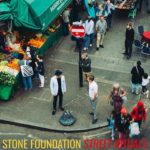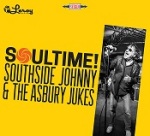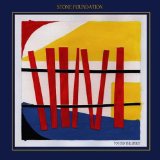 Twenty albums in twenty years; that’s not bad going, particularly when you have a day job fronting up for Jools Holland’s Rhythm and Blues Orchestra. You probably know that Ruby Turner has a fabulous voice, but she’s much more than the chanteuse with Jools Holland; Ruby Turner is a genuine British soul phenomenon with a career stretching back into the mid-eighties and some astonishing live and recorded performances (if you haven’t already heard it, check out her version of “Stay With Me Baby”). So, what’s the deal with Ruby’s latest album, “Love Was Here”?
Twenty albums in twenty years; that’s not bad going, particularly when you have a day job fronting up for Jools Holland’s Rhythm and Blues Orchestra. You probably know that Ruby Turner has a fabulous voice, but she’s much more than the chanteuse with Jools Holland; Ruby Turner is a genuine British soul phenomenon with a career stretching back into the mid-eighties and some astonishing live and recorded performances (if you haven’t already heard it, check out her version of “Stay With Me Baby”). So, what’s the deal with Ruby’s latest album, “Love Was Here”?
A couple of things; this is mainly about Ruby recognising the influence of the people she listened to as she grew up and trying to create the feel and grooves of those artists without creating carbon copies. The second thing is that Ruby has pulled together a fabulous soul band (mainly from Sheffield, a very fertile ground for British soul musicians). The band is: Kat Eaton (backing vocals), Nick Atkinson (guitars), Joe Glossop (keys), Jeremy Meek (bass) and John Blease (percussion) – Google any one of them and see just who they’ve worked with. This is a quality outfit, and they do what quality outfits do; they create arrangements that support the song and the vocal perfectly without any fuss or showboating.
The songwriting team is Kat Eaton and Nick Atkinson and between them they pull off the very clever trick of creating a groove and style that suggests a particular artist while still sounding fresh and original. Of course they have a huge advantage in that the songs are being delivered by one of the UK’s finest soul voices. The songs and the arrangements pull in structural elements from the styles they’re emulating; there are a lot of examples of the old gospel technique of call and response, not just with vocals but also between instruments as well. The other technique that appears a lot is unison playing in various instrumental configurations.
You can listen to the songs yourself and work out which song is influenced by which musical hero; there are nods in the direction of Al Green, Curtis Mayfield, BB King and Ry Cooder mentioned in the sleeve notes but you’ll also find references to Marvin Gaye, Sam Cooke and Otis Redding (and probably many more if you dig deep enough). It’s a fitting tribute to the pioneers of soul.
“Love Was Here” actually started life as an EP with four or five songs, but gradually grew to full album status over a period of eighteen months. The songs hang together well and it’s generally a coherent piece of work, apart from the bonus track “Chasing Love” from the film “The Host”. It’s the only song that wasn’t recorded at The Foundry in Sheffield and it’s very different, featuring a haunting solo violin and orchestral backing. It’s not better or worse than the other ten songs; it’s just very different.
“Love was Here” is the sound of great musicians lovingly evoking their musical influences, fronted up by a great British soul voice and it’s out now.
 OK, let’s get this straight from the start. It’s Stone Foundation; not The Stone Foundation. It’s an important distinction because the name has layers of meaning. It’s a reference to the solid bond uniting the core of the band: Neil Jones, Neil Sheasby, Phil Ford and Ian Arnold. But it’s also a reference to the foundations that underpin the band, the songwriting partnership of Neil Jones and Neil Sheasby and the locked-in, rock-solid rhythm section of Neil Sheasby and Phil Ford. That’s not to understate the importance of Ian Arnold’s keyboards or Rob Newton’s congas, but none of it can happen without the purring V8 (I know, mixed metaphors) engine.
OK, let’s get this straight from the start. It’s Stone Foundation; not The Stone Foundation. It’s an important distinction because the name has layers of meaning. It’s a reference to the solid bond uniting the core of the band: Neil Jones, Neil Sheasby, Phil Ford and Ian Arnold. But it’s also a reference to the foundations that underpin the band, the songwriting partnership of Neil Jones and Neil Sheasby and the locked-in, rock-solid rhythm section of Neil Sheasby and Phil Ford. That’s not to understate the importance of Ian Arnold’s keyboards or Rob Newton’s congas, but none of it can happen without the purring V8 (I know, mixed metaphors) engine.
And the rhythm section (along with the rest of the band) can turn on a sixpence as well. “Love Rediscovered” has the band alternating tempos and time signatures in a jazz-inflected piece with gentle ensemble horns and some lovely background sax fills. In many ways it’s the least typical song on the album, but it has a strand of the common thread of social commentary running through it. In that respect it’s a lot like the Marvin Gaye and Curtis Mayfield social consciousness albums of the early seventies.
The big ticket news item is always going to be the involvement of Paul Weller as producer, co-writer, player and singer. On the two previous albums, the band have attracted some high-profile guests, but nothing quite in this league. The most obvious influence is in the current single “The Limit of a Man”, which has hints of Style Council, although there are suggestions of Brenton Wood’s “Gimme Little Sign” and Curtis Mayfield’s “Move On Up” in there as well. It’s a gloriously upful song and should, by rights, be all over the radio.
Paul Weller aside, there are guest appearances from Bettye Lavette on the midtempo “Season of Change”, full of horn stabs and parping baritone sax, and William Bell on “Strange People” with, strings, Hammond, horns, a flute solo and even a bit of cowbell. Both singers still sound fabulous. On the ‘business as usual’ front, Neil Jones’ vocals seem to get better with each album and Neil Sheasby has created some lovely melodic basslines.
Stone Foundation managed something wonderful with “Street Rituals”. They’ve expanded their musical palette by adding flute, more strings and some over-driven guitar to the usual mix of piano, Hammond and horns to create a timeless vibe that’s thoroughly modern while acknowledging its roots. There’s a lot going on with “Street Rituals”; it sounds gorgeous on the first listen, but on repeat keeps revealing more and more. Is there a better British soul band at the moment? I very much doubt it.
“Street Rituals” is released on Friday March 31 on 100 Per Cent Records.
 If you’re looking for something that’s easy on the ear to use as aural wallpaper for your commute or as background music for a dinner party, then stop right here; this is proper music. Southside Johnny has been making music with various Asbury Jukes for over forty years and compromise isn’t something that he’s about to start now. The quality of the songs, the playing and the arrangements is what it’s all about; always has been, always will be. Southside had fraught relationships with his various labels in the days when bands signed to a label and hoped that the label would make them successful but it hasn’t worked that way for a while now so Southside has moved on to a completely different way of working; he has control over the creative and business processes. ‘When’s the album being released? When it’s ready’. And “Soultime!” is well and truly ready. It’s taken a while (the last album “Pills and Ammo” was released in 2010), but Southside’s a very busy man these days; not only is he trying to keep an eight-piece rock and soul band in line, but he’s also working with his Americana project The Poor Fools, comprising various Jukes and some of the extended Jersey shore family.
If you’re looking for something that’s easy on the ear to use as aural wallpaper for your commute or as background music for a dinner party, then stop right here; this is proper music. Southside Johnny has been making music with various Asbury Jukes for over forty years and compromise isn’t something that he’s about to start now. The quality of the songs, the playing and the arrangements is what it’s all about; always has been, always will be. Southside had fraught relationships with his various labels in the days when bands signed to a label and hoped that the label would make them successful but it hasn’t worked that way for a while now so Southside has moved on to a completely different way of working; he has control over the creative and business processes. ‘When’s the album being released? When it’s ready’. And “Soultime!” is well and truly ready. It’s taken a while (the last album “Pills and Ammo” was released in 2010), but Southside’s a very busy man these days; not only is he trying to keep an eight-piece rock and soul band in line, but he’s also working with his Americana project The Poor Fools, comprising various Jukes and some of the extended Jersey shore family.
Through the various incarnations of The Jukes, Southside has always had a collaborator helping with songwriting and musical director duties; Steve van Zandt moved on to the E Street Band as Springsteen went up through the gears and Bobby Bandiera took on the ‘safe pair of hands’ role with Bon Jovi on his seemingly endless world tour. Which, after an overlap with Bobby, left Jeff Kazee, keyboard virtuoso with a great high tenor soul voice, as the partner in crime. And, as much as I love the work of Little Steven and Bobby Bandiera, the Jeff and Johnny combination is producing some stunning results as Southside takes more credit for his songwriting contributions and Jeff Kazee adds his voice to the mix as well; it’s a potent combination.
In 2001, Southside released “Messin’ with the Blues”, an album of songs illustrating his love of blues, but also demonstrating the variety of styles within blues music; fourteen years later, “Soultime!” applies the same template to a cross-section of soul styles. It’s not too difficult to identify the influences, but the quality of the writing and the performances ensure that this is an album to be judged on its own merits.
The opening track “Spinning” throws all the ingredients into the blender to create a manic Stax feel. Everything’s there, from the horn fills to the breakdown, building back up with John Conte’s bass, Jeff Kazee’s Hammond and Glenn Alexander’s guitar, to the call and response vocal and the big horn finish. There’s barely time to get your breath back before “All I Can Do” the mid-tempo Johnny/Jeff duet. The two voices combine perfectly and a sweet tenor sax solo from John Isley is the icing on the cake. “Don’t Waste my Time” could be early Jukes, musically and lyrically as Southside tells the ‘my girl done me wrong’ story supported by backing vocalists Elaine Caswell, Layonne Holmes and Catherine Russell before Neal Pawley steps up for a trombone solo.
“Looking for a Good Time” is the album’s defining song. The inspiration for the album came from hearing “Superfly” in the booze aisle at the supermarket and watching how the shoppers reacted. “Looking…” captures the upful mood of Curtis Mayfield in 1970 perfectly; if anything ever made me wish I could dance, this is it. The namechecks in the lyrics say it all, really: ‘Isley Brothers and Curtis and Sly and Bobby Womack too’; it’s perfect. “Words Fail Me” is a mature love ballad with very tasteful backing (even drummer Tom Seguso is reined in), muted horns and a lovely flugelhorn solo from Chris Anderson; Johnny’s voice is sublime and it would melt a heart of stone. “Walking on a Thin Line” has a faintly menacing Latin feel evoking Isaac Hayes, The Temptations and The O’Jays but still totally Jukes.
What comes next is a very rare thing indeed; an instrumental on a Jukes album. “Klank” is the love child of “Soul Finger” and “Third Stone from the Sun” with harmonica and tenor sax solos; they’re allowed to have fun as well, you know. Carrying on with the levity, “Ain’t Nobody’s Bizness” is a bit of light-hearted fun with a cast of Damon Runyon characters and a nod to “Check Mr Popeye” from way back when, which takes the intensity down a little bit before the final three songs.
“I’m Not That Lonely” totally nails the Motown sound (Four Tops, anyone?) while “The Heart Always Knows” harks back to a much earlier time (Sam Cooke, or maybe The Cascades). It’s a slow, gentle ballad with some nice pizzicato strings courtesy of Jeff Kazee and acoustic guitar from Glenn Alexander and it takes off the heat for a few minutes before the final offering. “Reality” takes its influence from the psychedelic soul of the late sixties/early seventies with some interesting synth sounds and John Isley’s flute (and is that bass sax on there as well?), strings and muted horns; it gets kinda busy in there at times.
Southside Johnny set out to evoke a certain era of soul with this album; he wanted to make us feel good, the way we did when we first heard all of the great artists who influenced this album, and it’s an unqualified success. The arrangements perfectly capture the feel without sounding like The Faux Tops; he and The Jukes have created a perfect homage to music that was the soundtrack to the sixties and seventies. Over forty years down the line, he still has that raw, emotive voice that cuts through Hammond and horns and straight to the heart. Working with Jeff Kazee and the latest incarnation of The Jukes, he’s turned out a modern soul classic.
“Soultime!” is released on September 1 on Leroy Records.
 Sometimes it’s shocking that a band can be around for nearly ten years playing quality music without ever grabbing your attention; maybe it’s because, contrary to popular belief, there are still hundreds of superb bands out there and it’s just possible to occasionally miss one. So I have to apologise to Stone Foundation; let’s hope I can make up for my shocking ignorance. Before I even start on the music, I have to say that there’s an attitude about the band that evokes the early days of Dexys Midnight Runners; the band page on their website reads like one of Kevin Rowland’s legendary communiqués in the band’s heady early days. There are lots of underplayed references to their influences on the website as well, but you can find those for yourself.
Sometimes it’s shocking that a band can be around for nearly ten years playing quality music without ever grabbing your attention; maybe it’s because, contrary to popular belief, there are still hundreds of superb bands out there and it’s just possible to occasionally miss one. So I have to apologise to Stone Foundation; let’s hope I can make up for my shocking ignorance. Before I even start on the music, I have to say that there’s an attitude about the band that evokes the early days of Dexys Midnight Runners; the band page on their website reads like one of Kevin Rowland’s legendary communiqués in the band’s heady early days. There are lots of underplayed references to their influences on the website as well, but you can find those for yourself.
The band members are Neil Jones (vocals, guitar and harmonica), Neil Sheasby (bass), Ian Arnold (Hammond), Philip K Ford (drums), Spencer Hague (trombone), Lynn Thompson (trumpet) and Gary Rollins (saxophone and flute). They’ve been touring as headliners and recently as support to acts like The Specials on their recent arena tour, steadily building up their own fanbase and “To Find the Spirit” is their fifth studio album. This is a band which wears its influences proudly on its sleeve; if it’s remotely soulful and it was made in the 60s or 70s, it’s probably had an influence on Stone Foundation. The playing is of the very highest quality but this isn’t about style over substance and flashy solos; on “To Find the Spirit”, everything is beautifully arranged for the seven-piece ensemble and nothing is out of place. And if that isn’t enough for you, there are guest appearances from soul legend Nolan Porter, 60s icon and soul survivor Andy Fairweather Low, former Dexys bass player Pete Williams, journalist and soulboy Paolo Hewitt and the fabulous former Young Disciple Carleen Anderson.
The album pulls you in instantly with the opening bass, guitar and Hammond crescendo of “To Find the Spirit” leading into a horn arrangement that wouldn’t sound out of place on a Southside Johnny record; to make things better still, it evoked memories of the 70s Natalie Cole classic, “This Will Be”. A pretty good start really. “Bring Back the Happiness” (featuring Nolan Porter) starts with a clean guitar riff and Hammond chords and tips more than a wink to Booker T’s “Time is Tight”. “That’s the Way I Want to Live my Life” again has a lovely Stax feel, presenting us with the rare treat of a trombone solo and you really don’t hear enough of those these days. “When You’re in My World” (featuring Carleen Anderson and the Q Strings) continues in a similar 60s feel with a lovely understated sax solo before the thunderous drum and pure Dexys horn intro leads into “Stronger Than Us”.
“Don’t Let the Rain” is, I suspect quite deliberately, the centrepiece of the album with its laid-back positive message and gradual build-up over nearly nine minutes using all the elements of the band (particularly sax and muted trumpet) in the arrangement, and it’s followed by the slow 60s groove of “Crazy Love”, again featuring a Nolan Porter vocal. “Telepathic Blessing”, with its moody electric piano intro, builds to an ending which has the Hammond and horns working perfectly together. “Hold On”, featuring Andy Fairweather Low, with its mid-tempo feel could be a post-Impressions Curtis Mayfield song and I don’t throw compliments like that around lightly.
“Child of Wonder” is an interesting combination of a surreal Paolo Hewitt rites-of-passage monologue set against a jazz-funk background (built around the bass riff from Roy Budd’s “Get Carter” theme) evoking smoky LA bars lit by out-of focus neon lights. If you’ve heard “Over the Border”, the opening track from the recent Saint Etienne classic album “Words and Music”, you might hear a few similarities. “Wondrous Place”, featuring Pete Williams is the mid-tempo, Hammond and horn-led closer to the album before the bonus Dennis Bovell dub mix of “Don’t Let the Rain”, which creates a lot of space and doesn’t try to compensate with a lot of unnecessary effects.
If you’ve ever liked anything by Booker T and the MGs, Young Disciples, Nuyorican Soul or anything on Stax and Atlantic, then you’ll love this. “To Find the Spirit” is a labour of love where the songs, the performances and the arrangements dovetail perfectly to create a seductive and glorious stew of influences which still sounds vibrant and contemporary.
Released March 10 2014 on Republic of Music, via Universal (CD – TPCD007, Vinyl – TPL007).


